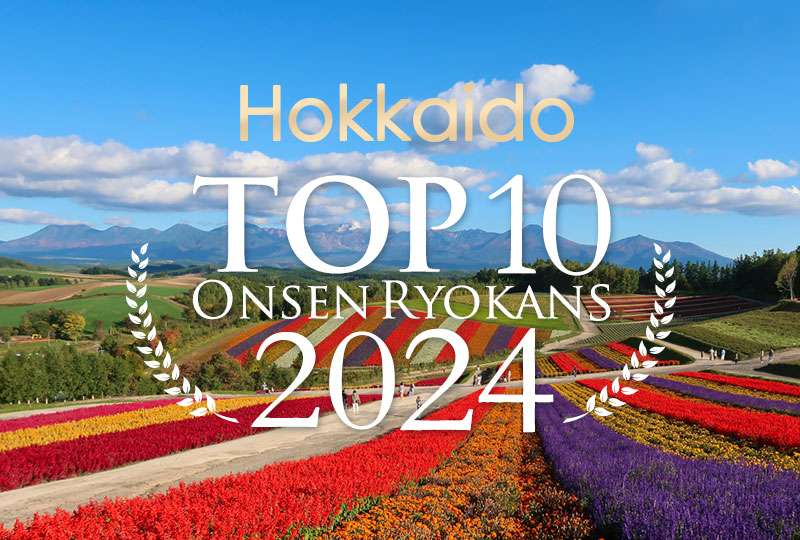Hokkaido is rich with diverse tourist destinations, catering to nature lovers, outdoor enthusiasts, and cultural explorers alike.
Here’s a roundup of some must-visit places:
1. Sapporo
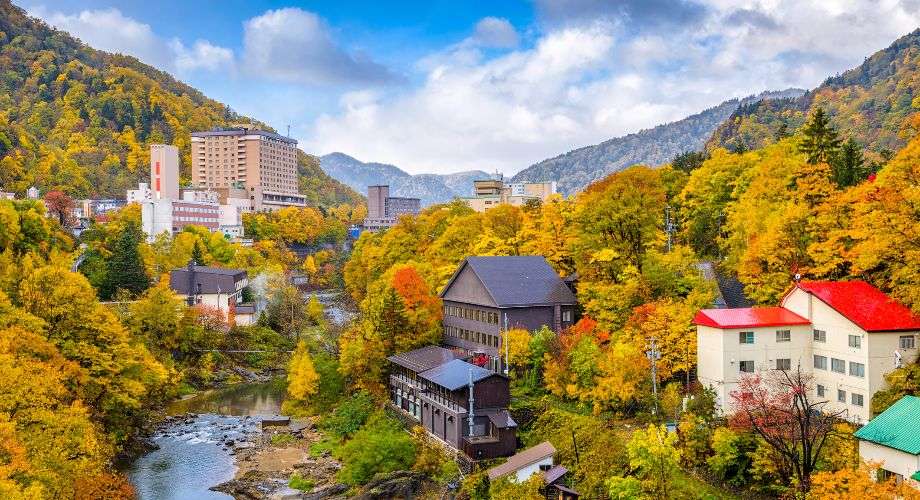
- Sapporo Snow Festival:
The Sapporo Snow Festival, held annually every February, is one of Japan’s most iconic winter events, drawing visitors from around the globe. This spectacular festival transforms the city into a frozen wonderland with colossal snow and ice sculptures that captivate the imagination. The festival features three main sites: Odori Park, where the largest and most intricate sculptures are displayed; Susukino, known for its dazzling ice sculptures and illuminated displays; and Tsudome, which offers family-friendly activities and snow slides. Throughout the festival, you can marvel at the creativity and craftsmanship behind the elaborate ice and snow art, participate in various winter activities, and enjoy a festive atmosphere that makes Sapporo’s winter nights truly magical.
Odori Park:Situated in the heart of Sapporo, Odori Park serves as the city’s central green space and a focal point for various events and activities. Stretching over 1.5 kilometers, the park is a lush, open area that provides a scenic respite from the urban hustle. In addition to being the main venue for the Sapporo Snow Festival, Odori Park is a popular spot for seasonal festivals, outdoor performances, and local markets. Its well-maintained gardens, fountains, and open lawns offer a tranquil setting for leisurely walks, picnics, or simply relaxing while taking in views of the surrounding cityscape. The park is also lined with historical monuments and statues, adding to its cultural significance.
Sapporo Beer Museum:
The Sapporo Beer Museum invites visitors to explore the rich history and tradition of beer brewing in Japan. Housed in a stunningly preserved brick building from the early 20th century, the museum provides an engaging and informative experience about the evolution of beer production in Japan. Exhibits showcase the brewing process, the history of Sapporo Beer, and the impact of beer on Japanese culture. After touring the museum, guests can enjoy a tasting session in the museum’s adjacent beer hall, where they can sample a variety of Sapporo’s brews, including seasonal and limited-edition varieties. The museum’s atmosphere combines historical charm with modern amenities, making it a delightful stop for both history enthusiasts and beer lovers.
District:
Susukino District is Sapporo’s vibrant entertainment and nightlife hub, offering a dynamic and diverse range of experiences. This bustling area is renowned for its lively atmosphere, with numerous bars, restaurants, clubs, and entertainment venues that cater to every taste and preference. Susukino comes alive in the evenings with neon lights, lively crowds, and a variety of dining options, from traditional izakayas (Japanese pubs) to upscale eateries and international cuisine. The district is also home to karaoke bars, nightclubs, and theaters, providing endless entertainment possibilities. Whether you’re looking to enjoy a casual meal, experience Sapporo’s nightlife, or simply soak in the energetic ambiance, Susukino offers an unforgettable urban adventurE
These descriptions provide a detailed and inviting overview of each attraction, highlighting what makes them unique and appealing.poro Snow Festival: Held every February, this famous festival features massive snow and ice sculptures and attracts visitors from around the world. - Odori Park: A central park in Sapporo that hosts various events and provides a scenic spot to relax.
- Sapporo Beer Museum: Explore the history of beer brewing in Japan and sample local brews.
- Susukino District: The city’s entertainment and nightlife hub, known for its vibrant atmosphere and diverse dining options.

2. Otaru
Otaru Canal:
The Otaru Canal is a captivating destination that offers a glimpse into the city’s maritime past. Lined with beautifully restored historic warehouses, the canal has been transformed into a charming promenade where the architectural elegance of the past meets contemporary vibrancy. Stroll along the canal’s cobblestone paths, and you’ll find yourself surrounded by charming shops, cozy cafes, and inviting restaurants. The canal is especially magical in the evening when the gas lamps cast a warm, nostalgic glow over the water, creating a romantic and serene atmosphere. During the winter months, the scene is enhanced by snow-covered landscapes and festive lights, adding to the canal’s enchanting charm.
Sakaimachi Street:
Sakaimachi Street is a must-visit destination for those interested in traditional Japanese crafts and local culture. This historic shopping street is renowned for its well-preserved architecture, which reflects the city’s rich heritage. As you wander down Sakaimachi Street, you’ll discover a variety of unique shops specializing in traditional Japanese goods, including exquisite glassware, handcrafted music boxes, and intricately designed ceramics. The street is a haven for those looking to purchase high-quality souvenirs and gifts that embody the artistry and craftsmanship of the region. The atmosphere is both nostalgic and lively, with local artisans often showcasing their skills and sharing the stories behind their crea
- Otaru Aquarium: A family-friendly spot showcasing marine life from the region.

3. Hakoda: Certainly! Here’s an extended description of each of these Hakodate attractions:
Mount Hakodate:
Mount Hakodate, standing at 334 meters above sea level, offers one of Japan’s most breathtaking panoramic views. The summit provides a sweeping vista of Hakodate city, its picturesque harbor, and the surrounding ocean. The view is particularly enchanting at night when the city lights create a dazzling, glittering tapestry that stretches across the bay. The observation area at the top is accessible by a convenient cable car ride, which adds to the experience by offering scenic views of the city and the surrounding landscape during the ascent. Whether visiting during the day to enjoy the natural beauty or at night to marvel at the sparkling cityscape, Mount Hakodate promises a memorable and visually stunning experience.
Goryokaku Fort:
Goryokaku Fort is a historically significant landmark in Hakodate, renowned for its distinctive star-shaped design, which reflects the advanced military architecture of the late Edo period. Originally built in the 19th century as a defensive fortification, it now serves as a public park that invites visitors to explore its historical and architectural heritage. The fort’s star-shaped layout, complete with moats and well-preserved outer walls, is best appreciated from the observation tower, which provides panoramic views of the fort’s unique structure and the surrounding cityscape. The park is also home to a variety of cherry trees, which bloom spectacularly in the spring, making it a popular spot for hanami (flower viewing). The fort’s historical significance is highlighted through informative displays and guided tours, providing a deeper understanding of its role in Japan’s modernization.
Hakodate Morning Market:
The Hakodate Morning Market is a lively and bustling marketplace that offers a vibrant array of fresh seafood, local produce, and traditional Japanese delicacies. Located near Hakodate Station, this market is an essential destination for food lovers and those seeking an authentic local experience. Early morning visitors can explore a wide selection of seafood stalls, where they can sample and purchase freshly caught fish, shellfish, and other marine delicacies. The market is also home to various food vendors offering delicious local specialties, such as seafood bowls (kaisendon), grilled squid, and seasonal fruits. The lively atmosphere, coupled with the opportunity to taste and purchase some of the freshest produce in the region, makes the Hakodate Morning Market a must-visit for anyone explore
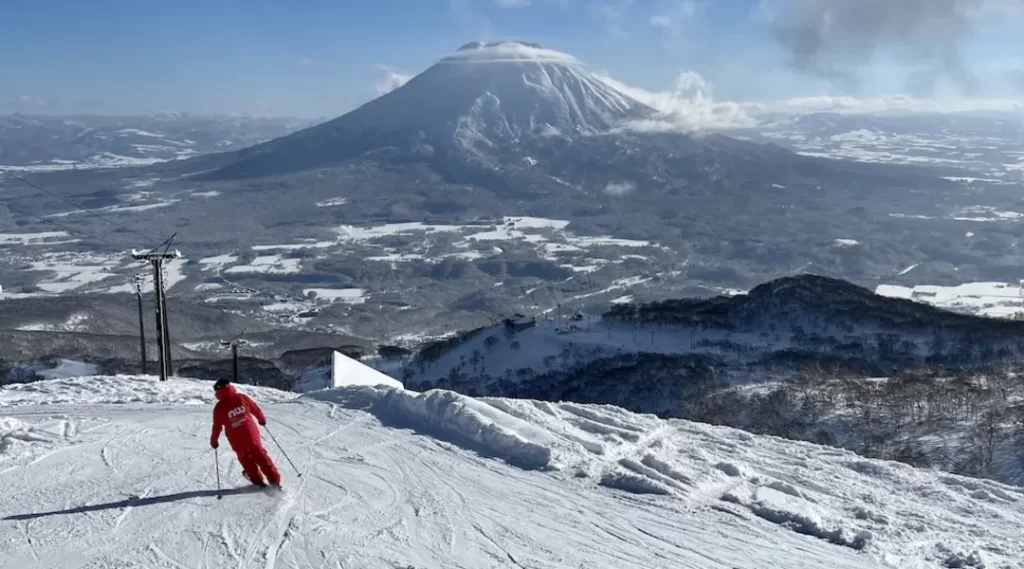
4. Niseko
Niseko United:
Niseko United is a premier ski resort area located in the northern part of Hokkaido, renowned globally for its exceptional powder snow and outstanding winter sports conditions. This expansive collection of four interconnected ski resorts—Niseko Grand Hirafu, Niseko Hanazono, Niseko Village, and Niseko Annupuri—offers a diverse range of slopes, from beginner-friendly trails to challenging expert runs. The region’s unique geography and climate contribute to its famously light and fluffy powder snow, attracting skiers and snowboarders of all levels seeking the ultimate snow experience. In addition to its world-class skiing and snowboarding, Niseko United features state-of-the-art facilities, including modern lifts, rental shops, and ski schools, ensuring a seamless and enjoyable experience for visitors.
Beyond the slopes, Niseko United provides a vibrant après-ski scene with a variety of restaurants, bars, and shops. The area is also known for its stunning mountain views and opportunities for off-piste adventures, including backcountry skiing and snowshoeing. Whether you’re hitting the slopes during the day or relaxing in a cozy mountain lodge in the evening, Niseko United delivers an exceptional winter getaway.
Onsen (Hot Springs):
Niseko is also celebrated for its numerous onsen (hot springs), offering a relaxing retreat after a day on the slopes. The region’s volcanic activity creates a wealth of natural hot springs, each providing a unique experience. Many of Niseko’s onsens are set in picturesque locations, allowing guests to soak in their mineral-rich waters while enjoying stunning views of the surrounding mountains and snow-covered landscapes. Some onsens offer outdoor baths (rotemburo) that provide a serene and invigorating experience amidst the natural beauty of the area.
In addition to their therapeutic benefits, Niseko’s onsens often feature a range of amenities, such as saunas, steam rooms, and relaxation areas, making them a perfect spot to unwind and rejuvenate. Whether you prefer a traditional ryokan (Japanese inn) with an onsen or a modern spa facility, the hot springs in Niseko add an extra layer of luxury and relaxation to your winter adventure. The combination of soothing warm waters and breathtaking scenery makes soaking in these onsens an unforgettable experience that enhances the overall appeal of Niseko
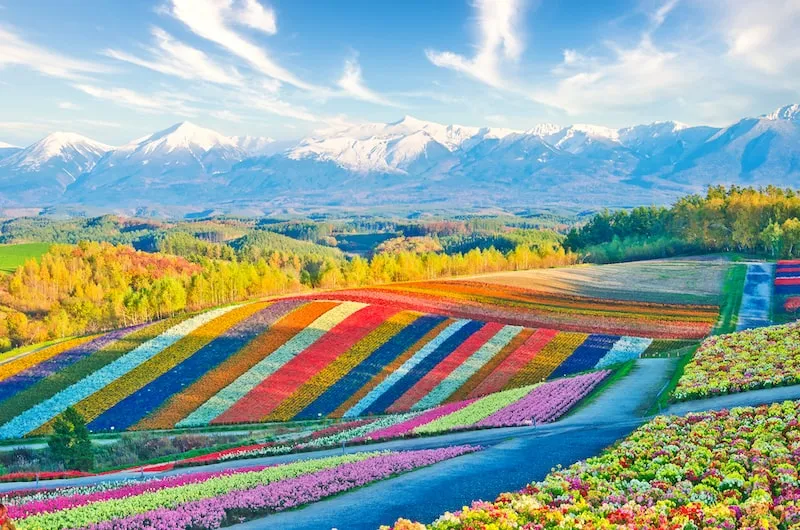
5. Furano
Furano Ski Resort:
Furano Ski Resort, located in the heart of Hokkaido, is a premier destination for winter sports enthusiasts, celebrated for its exceptional skiing and snowboarding conditions combined with breathtaking alpine scenery. Renowned for its light, powdery snow, Furano offers a versatile array of runs that cater to skiers and snowboarders of all skill levels, from beginners to seasoned pros. The resort is divided into two main areas: the Kitanomine Zone and the Furano Zone, each offering unique features and challenges.
The Kitanomine Zone is favored for its challenging terrain, including steep slopes and thrilling off-piste opportunities, making it ideal for advanced skiers and snowboarders. The Furano Zone, on the other hand, features gentler slopes and well-groomed trails that are perfect for beginners and intermediate riders. Both areas provide stunning vistas of the surrounding mountain ranges and the picturesque town of Furano, enhancing the overall skiing experience with spectacular views.
In addition to its superb snow conditions, Furano Ski Resort is known for its well-maintained facilities and infrastructure. Modern lifts, including high-speed chairlifts and gondolas, ensure quick and comfortable access to the slopes. The resort also offers a range of services, including equipment rentals, ski schools, and ski patrol, to support a smooth and enjoyable visit. For those looking to take a break from the slopes, the resort features cozy lodges, charming cafes, and dining options where visitors can relax and refuel.
During the winter season, Furano Ski Resort becomes a vibrant hub of activity, attracting visitors with its festive atmosphere and variety of winter events. The resort’s ski patrol ensures safety on the slopes, while its friendly staff provides excellent customer service to enhance the overall experience. Whether you’re carving through fresh powder, enjoying the stunning alpine scenery, or unwinding in a mountain lodge, Furano Ski Resort offers a memorable and immersive winter adventure.
Moreover, Furano’s location provides easy access to nearby attractions and activities, such as snowshoeing, snowmobiling, and relaxing in local hot springs (onsen). The surrounding area is also known for its scenic beauty, with opportunities for sightseeing and exploring the charming town of Furano. The combination of top-notch skiing, picturesque landscapes, and additional winter activities makes Furano Ski Resort a must-visit destination for anyone seeking an exceptional winter getaway.
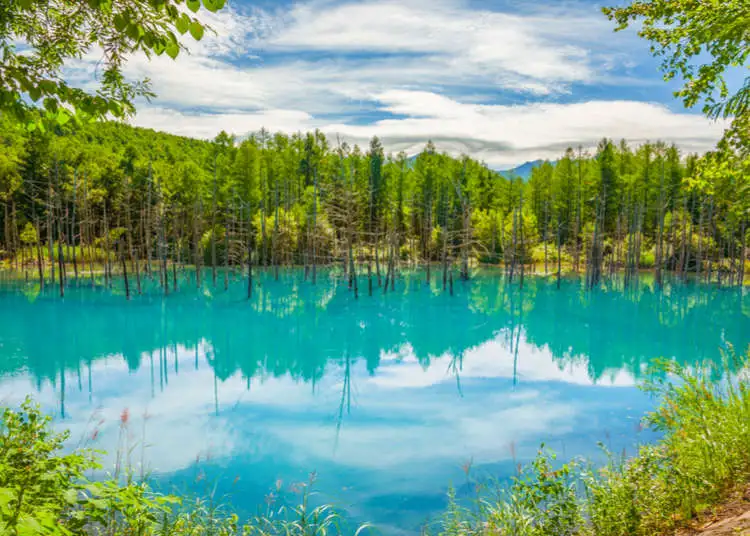
6. Biei
Blue Pond (Aoiike):
Blue Pond, or Aoiike, is a breathtaking natural wonder located in the town of Biei, Hokkaido. Renowned for its striking, surreal blue color, this pond has become one of the most iconic and photographed landscapes in Japan. The pond’s distinctive hue is a result of the natural minerals and sediment suspended in the water, which creates a vivid, otherworldly blue that seems almost too vibrant to be real. Surrounded by a tranquil forest of birch trees and set against a backdrop of rolling hills, the pond offers a serene and picturesque setting that changes with the seasons.
In spring and summer, the lush greenery contrasts beautifully with the pond’s blue waters, while autumn brings a stunning display of colorful foliage reflecting in the pond. During winter, the area transforms into a serene, snow-covered landscape, adding a magical touch to the already enchanting scene. The pond is accessible via well-maintained walking paths that allow visitors to explore its surroundings and capture its beauty from various angles. The peaceful atmosphere and unique natural colors make Blue Pond a must-visit for photographers, nature lovers, and anyone seeking a moment of tranquility amidst stunning scenery.
Patchwork Road:
Patchwork Road is a scenic route in Biei, Hokkaido, renowned for its picturesque rural landscapes and rolling hills. This charming drive takes visitors through a series of gently undulating fields and farmlands that resemble a patchwork quilt, hence the name. The road meanders through a variety of crops and fields, offering an ever-changing tableau of colors and textures that are particularly striking during the different seasons.
In summer, the fields are vibrant with the lush greens of crops like wheat and barley, punctuated by bursts of color from blooming flowers and vegetable patches. Autumn brings a warm palette of golden yellows, oranges, and reds, as the harvest season paints the landscape with rich hues. Winter turns the scene into a tranquil, snow-blanketed expanse, where the bare trees and fields create a serene and minimalist beauty.
As you drive along Patchwork Road, you’ll encounter several viewpoints and photo spots that offer panoramic vistas of the surrounding countryside. The route is dotted with quaint farms and picturesque rural settings, making it a delightful journey for those interested in capturing the beauty of Hokkaido’s rural landscape. The drive is not just a visual treat but also an opportunity to experience the peaceful, rural charm of the area, away from the bustling city life.
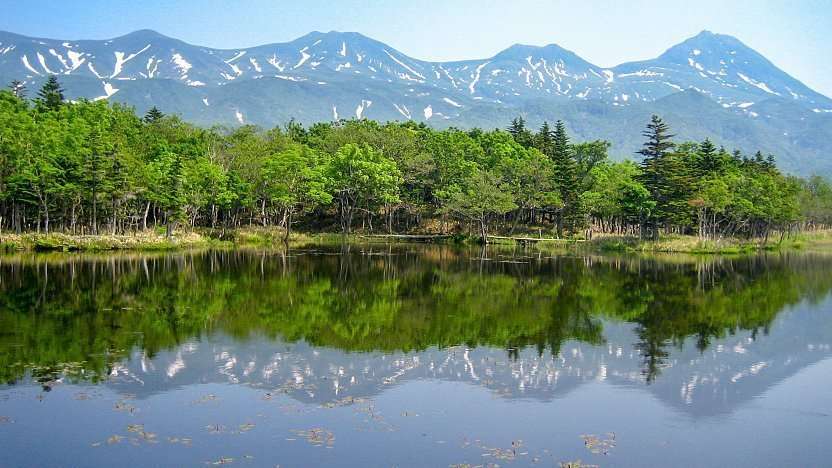
7. Shiretoko National Park
Shiretoko Five Lakes:
Shiretoko Five Lakes (Shiretoko Goko) is a captivating natural attraction located in Shiretoko National Park, one of Japan’s most pristine and ecologically significant regions. This series of five picturesque lakes is nestled in a remote corner of Hokkaido and is renowned for its serene beauty and rich biodiversity. The lakes are arranged in a cluster within a lush forested area, providing a tranquil setting for nature enthusiasts and photographers alike.
Visitors can explore the lakes via well-maintained boardwalks that meander through the surrounding wetlands and forested terrain. These boardwalks offer easy and convenient access to the lakes while minimizing environmental impact. From various vantage points along the boardwalks, visitors can enjoy stunning reflections of the surrounding mountains and forests in the crystal-clear waters. The area is particularly notable for its seasonal changes: vibrant green foliage in spring and summer, brilliant autumn colors, and serene, snow-covered landscapes in winter.
The Shiretoko Five Lakes area is also an excellent spot for wildlife viewing. Early morning or late afternoon visits often provide the best opportunities to see wildlife, including brown bears, which are known to roam the region. The lakes and their surroundings are home to diverse bird species, such as the Japanese crane and various ducks, making it a popular destination for birdwatchers. The peaceful setting and well-preserved natural environment make Shiretoko Five Lakes a must-visit for anyone interested in Japan’s natural beauty and wildlife.
Wildlife Viewing:
The Shiretoko Peninsula is renowned for its rich and diverse wildlife, offering exceptional opportunities to observe animals in their natural habitat. The region is particularly famous for its population of brown bears, which are often spotted in the Shiretoko Five Lakes area and the surrounding forests. These majestic creatures can be seen foraging for food, especially during the spring and summer months when they are most active.
In addition to brown bears, the peninsula is home to a variety of other wildlife, including Sika deer, which are commonly seen grazing in the area. Birdwatchers will find a wealth of avian species, such as the endangered Japanese crane, the peregrine falcon, and various other waterfowl that inhabit the wetlands and forests. The combination of diverse ecosystems and the region’s remote, pristine environment creates ideal conditions for observing wildlife in a relatively undisturbed setting.
Rausu:
Rausu is a charming small town situated on the eastern coast of the Shiretoko Peninsula, serving as a gateway to exploring the rugged and dramatic coastline of the region. Known for its stunning natural landscapes and excellent marine wildlife viewing opportunities, Rausu is a popular base for visitors seeking to experience the beauty of Shiretoko’s coastline and surrounding waters.
One of the highlights of visiting Rausu is the opportunity to embark on boat tours that explore the rugged coastline and offer spectacular views of sea cliffs, caves, and other geological formations. These tours provide a unique perspective of the Shiretoko Peninsula’s dramatic coastal scenery, which is often only accessible by sea. During the tours, there is also a chance to spot various marine wildlife, including seals and, depending on the season, even whales. The town’s location and proximity to the rich marine environment make it an ideal spot for whale watching, with several operators offering guided tours that increase the chances of encountering these magnificent creatures.
In addition to its natural attractions, Rausu is known for its local seafood, with fresh catches including crab, sea urchin, and various fish available at local restaurants and markets. The town’s warm and welcoming atmosphere, combined with its stunning natural surroundings, makes it a delightful destination for visitors seeking an immersive experience in one of Japan’s most pristine and scenic regions.

8. Daisetsuzan National Park
Asahidake:
Asahidake, standing at 2,291 meters, is the highest peak in Hokkaido and a prominent feature of the Daisetsuzan National Park. This majestic mountain offers a range of outdoor activities and natural wonders, making it a must-visit destination for nature enthusiasts and hikers. Asahidake is renowned for its breathtaking panoramic views, which extend across Hokkaido’s vast landscapes, including the surrounding peaks, valleys, and the distant coast. The summit provides a sweeping vista of the rugged terrain and, on clear days, can offer a view of the Pacific Ocean.
The mountain is accessible via a ropeway that takes visitors from the base to an elevation of approximately 1,600 meters, significantly reducing the hiking effort required to reach the upper trails. From the ropeway station, several hiking trails of varying difficulty lead to the summit and other scenic viewpoints. The trails offer the opportunity to explore diverse alpine flora, volcanic terrain, and volcanic craters, adding to the mountain’s allure. During the summer months, the landscape is dotted with vibrant wildflowers, while in autumn, the area transforms into a stunning tapestry of red, orange, and yellow hues. In winter, Asahidake becomes a popular destination for backcountry skiing and snowboarding, attracting winter sports enthusiasts with its deep powder snow and challenging terrain.
Sounkyo Gorge:
Sounkyo Gorge is a captivating natural attraction located in the heart of Daisetsuzan National Park, renowned for its dramatic rock formations, cascading waterfalls, and seasonal foliage. This picturesque gorge is carved by the flow of the Ishikari River and features a variety of stunning natural landscapes, including rugged cliffs, lush forests, and serene river vistas. The gorge is particularly famous for its beautiful waterfalls, such as the impressive Ginga Falls and Ryusei Falls, which tumble down the rocky cliffs and create a mesmerizing spectacle, especially during the spring melt and after heavy rains.
The area offers an array of hiking trails that cater to different skill levels, providing visitors with various ways to experience the natural beauty of Sounkyo Gorge. These trails range from leisurely walks along the riverbanks to more challenging hikes that ascend the surrounding ridges and offer panoramic views of the gorge and the surrounding landscape. In autumn, Sounkyo Gorge becomes a popular destination for leaf-peeping, as the surrounding trees burst into vibrant hues of red, orange, and yellow, creating a stunning contrast with the rocky terrain and waterfalls.
In addition to hiking and sightseeing, Sounkyo Gorge is home to several onsen (hot springs) where visitors can relax and soak in the therapeutic waters while enjoying views of the natural surroundings. The combination of striking geological features, scenic waterfalls, and seasonal beauty makes Sounkyo Gorge a must-visit destination for anyone exploring Hokkaido’s natural wonders.

9. Noboribetsu
Noboribetsu Onsen:
Noboribetsu Onsen is one of Japan’s most celebrated hot spring resorts, located in the city of Noboribetsu in Hokkaido. Renowned for its exceptional geothermal activity, this onsen town is a haven for those seeking relaxation and therapeutic benefits from natural hot springs. The area is distinguished by its diverse range of mineral-rich baths, each offering unique properties and health benefits due to the different types of geothermal waters found in the region.
The resort’s hot springs are fed by volcanic activity from the nearby Hell Valley (Jigokudani), resulting in a variety of onsen types, including sulfuric, saline, and acidic baths. These mineral-rich waters are reputed to aid in the relief of various ailments, such as joint pain, skin conditions, and fatigue. Visitors can enjoy a range of bath experiences, from traditional public baths to private outdoor hot spring baths, many of which offer picturesque views of the surrounding natural scenery.
In addition to its therapeutic baths, Noboribetsu Onsen features a range of accommodations, including traditional ryokan (Japanese inns) and modern hotels, all of which provide guests with access to their own onsen facilities. The town itself is charming and welcoming, with various dining options that feature local specialties, including fresh seafood and regional delicacies. The combination of high-quality hot spring baths, serene natural surroundings, and comfortable lodging makes Noboribetsu Onsen a premier destination for relaxation and wellness.
Hell Valley (Jigokudani):
Hell Valley, or Jigokudani, is a dramatic and fascinating volcanic area located near Noboribetsu Onsen. This geothermal wonderland is characterized by its rugged, otherworldly landscape, which is marked by steaming vents, bubbling sulfuric pools, and fumaroles that emit pungent sulfur gases. The name “Hell Valley” reflects the area’s intense geothermal activity and the eerie, yet captivating atmosphere created by the volcanic features.
The valley’s geothermal activity is a result of magma heating groundwater, which rises to the surface and creates a variety of hot springs and thermal features. The landscape is both surreal and mesmerizing, with steam rising from the ground and the scent of sulfur permeating the air. Visitors can explore the valley via well-maintained walking trails that offer vantage points for viewing the steaming vents, hot springs, and the surrounding rugged terrain. The trails are designed to provide safe access to the valley’s unique features while preserving the natural environment.
Hell Valley is also home to several observation decks and information boards that explain the geological processes and the history of the area. The striking visual contrast of the stark volcanic landscape with the lush greenery of the surrounding forest adds to the area’s dramatic appeal. The valley’s geothermal features feed into the hot springs of Noboribetsu Onsen, making it an integral part of the region’s onsen experience. Exploring Hell Valley offers a fascinating insight into the power of volcanic activity and provides a memorable and immersive experience for visitors.
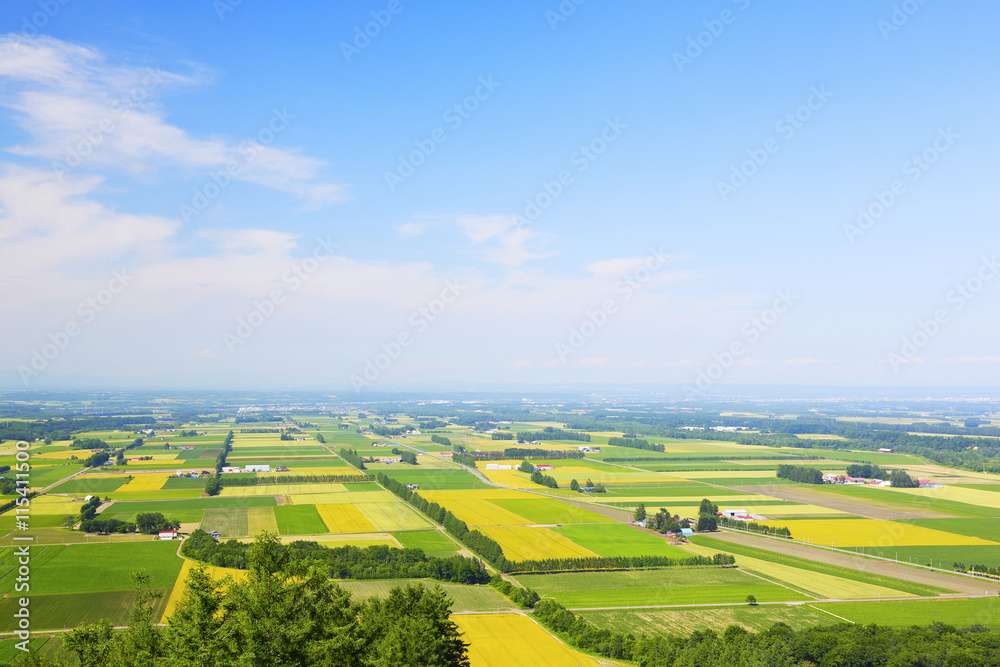
10. Tokachi
Tokachi Millennium Forest:
Tokachi Millennium Forest is an expansive and meticulously designed park located in the Tokachi region of Hokkaido, renowned for its stunning landscape, diverse gardens, and artistic installations. Spanning over 200 hectares, this beautifully landscaped area serves as a testament to sustainable design and environmental stewardship, offering visitors a serene and immersive experience in nature.
The park is divided into several distinct zones, each showcasing different aspects of horticulture and landscape design. The “Nature Garden” emphasizes the natural beauty of the region, featuring native plants and trees that blend harmoniously with the surrounding environment. The “Flower Garden” is a vibrant display of seasonal blooms, providing a burst of color and fragrance throughout the year. The “Art Garden” features a variety of artistic installations and sculptures that enhance the natural beauty of the landscape, creating a unique fusion of art and nature.
In addition to its gardens, Tokachi Millennium Forest offers an array of nature trails that meander through forests, meadows, and wetlands, allowing visitors to explore the park’s diverse ecosystems. These trails are designed to be accessible to all, providing easy walks as well as more challenging routes for those seeking a deeper connection with nature. Along the trails, visitors can enjoy panoramic views of the Tokachi Plain, the rolling hills, and the distant mountains.
The park also hosts various events and workshops throughout the year, including gardening seminars, art exhibitions, and seasonal festivals that highlight the region’s natural and cultural heritage. Visitors can enjoy local cuisine at the park’s restaurant, which features dishes made from locally sourced ingredients, offering a taste of the Tokachi region’s agricultural bounty. Tokachi Millennium Forest provides a tranquil retreat for those seeking relaxation and inspiration, making it a must-visit destination for nature lovers and art enthusiasts alike.
Obihiro:
Obihiro, a vibrant city located in the Tokachi region of Hokkaido, is known for its rich agricultural heritage and delicious culinary offerings. As a major agricultural hub, Obihiro boasts fertile lands and a favorable climate that contribute to its reputation for high-quality produce. The city’s markets and local shops are filled with an array of fresh fruits, vegetables, dairy products, and meats, reflecting the area’s commitment to agricultural excellence.
One of Obihiro’s most famous culinary delights is “Butadon,” a beloved pork rice bowl that highlights the city’s agricultural prowess. This dish features tender, savory pork belly slices grilled to perfection and served over a steaming bowl of rice, often accompanied by a sweet and tangy sauce. Butadon has become a signature dish of the region, with many local eateries offering their own unique takes on this flavorful specialty. The dish’s popularity extends beyond Obihiro, drawing visitors from all over Japan who come to experience its rich taste and satisfying texture.
In addition to its culinary scene, Obihiro is home to several cultural and recreational attractions. The city hosts a variety of festivals and events throughout the year, celebrating everything from local agriculture to traditional Japanese culture. Visitors can explore the Obihiro Zoo, which features a range of animal species and offers educational programs for families. The city’s historical sites, such as the Obihiro Shrine, provide insights into the region’s cultural heritage and offer a glimpse into its past.
Obihiro’s lively atmosphere, combined with its agricultural products and culinary delights, makes it a dynamic destination for travelers seeking an authentic taste of Hokkaido. The city’s welcoming community and diverse attractions ensure that visitors have a memorable and enjoyable experience while exploring the region’s rich traditions and natural beauty.

11. Abashir:
Abashiri Prison Museum:
The Abashiri Prison Museum, located in Abashiri City, Hokkaido, is a unique historical site that offers a compelling glimpse into the penal history of the region. Originally established in 1890, Abashiri Prison was one of Japan’s most notorious correctional facilities, known for its harsh conditions and the challenging environment in which it was situated. The prison was operational until 1984, when it was decommissioned and subsequently transformed into a museum.
The museum provides an immersive experience, allowing visitors to explore the well-preserved prison buildings and learn about the daily lives of the inmates who were housed there. Guided tours and informative exhibits offer insights into the history of the prison, including the architectural design, security measures, and the often grim realities of life behind bars. The museum’s exhibits include original prison cells, guard towers, and various artifacts related to the prison’s operations, such as uniforms, tools, and personal items belonging to both prisoners and guards.
One of the key features of the Abashiri Prison Museum is its focus on the social and historical context of the penal system in Hokkaido. The museum provides educational programs and historical presentations that explore the broader issues of crime and punishment in Japan, shedding light on the evolution of the penal system and its impact on society. The museum also hosts special events and exhibitions that delve deeper into specific aspects of prison life and penal history.
Visiting the Abashiri Prison Museum offers a thought-provoking and educational experience, providing valuable insights into a significant chapter of Hokkaido’s history and the challenges faced by those who lived within its walls.
Okhotsk Ryuhyo Museum:
The Okhotsk Ryuhyo Museum, located in Abashiri City, Hokkaido, is dedicated to the fascinating phenomenon of drift ice in the Sea of Okhotsk and its impact on the local marine environment. This museum offers a comprehensive exploration of drift ice, a natural occurrence where large sheets of ice break off from the Arctic and float southward into the Sea of Okhotsk, creating a dramatic and beautiful icy landscape.
The museum features a range of interactive exhibits and educational displays that explain the formation and movement of drift ice, as well as its significance to the local ecosystem. One of the highlights of the museum is the “Ice Experience Room,” where visitors can touch and feel real drift ice and learn about its physical properties. The museum also showcases the effect of drift ice on marine life, including how it influences the behavior and distribution of various species such as seals, sea birds, and fish.
The Okhotsk Ryuhyo Museum provides detailed information on the role of drift ice in the regional climate and its cultural and economic impact on the local communities. Visitors can explore exhibits on the traditional practices of local people who have historically relied on drift ice for various purposes, including fishing and ice harvesting. The museum also features multimedia presentations and guided tours that offer a deeper understanding of the ecological importance of drift ice and its influence on the environment.
In addition to its permanent exhibits, the museum hosts seasonal displays and educational programs that highlight different aspects of the drift ice phenomenon and its impact on the surrounding region. The Okhotsk Ryuhyo Museum offers a fascinating and informative experience for those interested in the natural world, climate science, and the unique ecological features of Hokkaido.
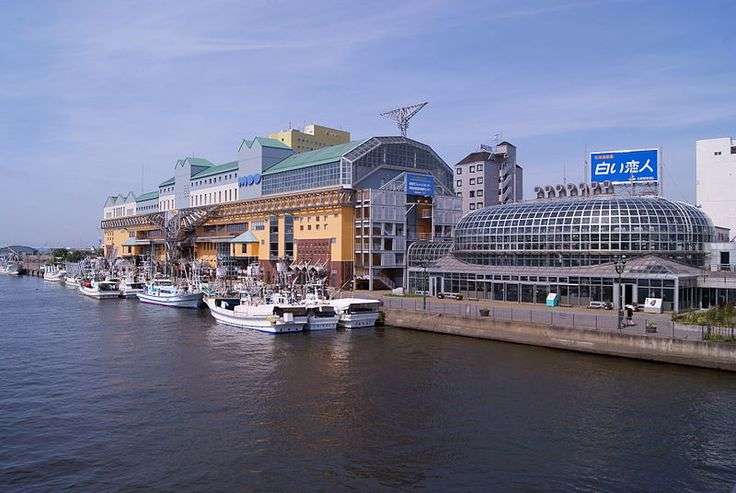
12. Kushiro
Kushiro Shitsugen National Park:
Kushiro Shitsugen National Park, located in eastern Hokkaido, is Japan’s largest wetland area, covering approximately 2,700 square kilometers. This expansive park is renowned for its diverse ecosystems, rich biodiversity, and stunning natural landscapes. The park’s vast wetlands, marshes, and peat bogs create a unique and picturesque environment that supports a wide range of flora and fauna.
The park is particularly notable for its abundant birdlife, making it a prime destination for birdwatchers. Among the many species that inhabit the park are the rare Japanese crane (Tancho), which is often seen performing its graceful courtship dances in the wetlands. Other notable species include the white-tailed eagle and various waterfowl that thrive in the park’s diverse habitats.
In addition to its avian residents, Kushiro Shitsugen National Park is home to a variety of plant species, including rare and endemic species that are specially adapted to the wetland environment. The park’s landscapes are characterized by sprawling marshlands, serene lakes, and flowing rivers, offering visitors a chance to experience the natural beauty of untouched wilderness.
The park features several well-marked trails and observation platforms that provide access to its scenic landscapes and wildlife viewing opportunities. Popular areas within the park include the Kushiro Marsh Observatory, which offers panoramic views of the wetlands and opportunities for wildlife spotting. The park’s walking trails, such as the Kushiro Shitsugen Trail, allow visitors to explore the diverse ecosystems up close, with interpretive signs providing information about the park’s natural features and wildlife.
Kushiro Shitsugen National Park is also an important area for conservation and research, with ongoing efforts to protect and preserve its delicate ecosystems. The park’s commitment to conservation ensures that visitors can enjoy its natural beauty while contributing to the preservation of this vital ecological area.
Kushiro Fisherman’s Wharf MOO:
Kushiro Fisherman’s Wharf MOO is a vibrant and bustling waterfront market located in the heart of Kushiro City, Hokkaido. This lively destination is a haven for seafood lovers and visitors seeking to experience the local culinary delights and maritime culture of the region. The market is situated along the scenic Kushiro waterfront, offering picturesque views of the harbor and easy access to the city’s maritime attractions.
At Kushiro Fisherman’s Wharf MOO, visitors can explore a diverse array of stalls and shops that showcase the freshest seafood and local products. The market is renowned for its high-quality seafood, including an assortment of fish, shellfish, and other oceanic delicacies. Popular items include fresh crab, sea urchin, and sashimi, which can be enjoyed at various food stalls and restaurants within the market. The market’s name, “MOO,” is derived from the Japanese word for “moo,” which reflects the market’s lively and bustling atmosphere.
In addition to seafood, Kushiro Fisherman’s Wharf MOO features a range of local products and souvenirs, including handmade crafts, regional specialties, and traditional Japanese goods. Visitors can also find a variety of eateries offering local dishes and snacks, providing a chance to sample the flavors of Hokkaido in a vibrant and communal setting.
The market is not only a place to enjoy delicious food but also a cultural experience, with opportunities to interact with local vendors and learn about the region’s maritime traditions. The waterfront location adds to the market’s appeal, offering a scenic backdrop for exploring and dining.
Overall, Kushiro Fisherman’s Wharf MOO provides a lively and engaging experience for visitors, combining the best of Hokkaido’s seafood and local culture in a picturesque waterfront setting.
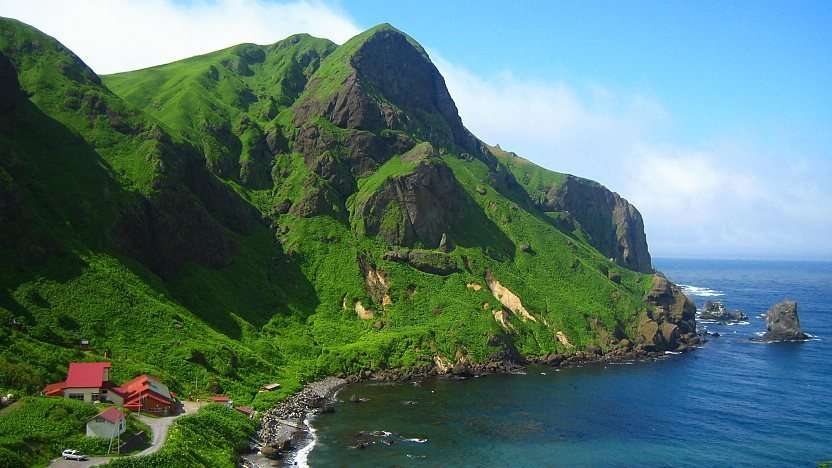
13. Rishiri and Rebun Islands
Rishiri Island:
Rishiri Island, located off the northwest coast of Hokkaido, is a stunning destination renowned for its natural beauty and outdoor adventure opportunities. Dominated by Mount Rishiri, a dormant volcano that rises to 1,721 meters, the island offers hikers and nature enthusiasts a chance to explore its rugged landscapes and enjoy breathtaking panoramic views.
Mount Rishiri, often referred to as “Rishiri-Fuji” due to its resemblance to Mount Fuji, is a central attraction of the island. The mountain features a variety of hiking trails that cater to different skill levels, from leisurely walks through lush forests to more challenging ascents that lead to the summit. The trails offer hikers spectacular views of the surrounding sea, the island’s volcanic terrain, and the distant mainland of Hokkaido. At the summit, visitors are rewarded with a sweeping vista that encompasses the neighboring Rebun Island and the vast expanse of the Sea of Japan.
In addition to hiking, Rishiri Island is known for its rich marine environment and diverse flora. The island’s coastline features dramatic cliffs, serene beaches, and rocky outcrops, creating a picturesque setting for exploration and relaxation. The island’s waters are home to a variety of marine life, including sea urchins and shellfish, which are often featured in local seafood dishes.
Rishiri Island’s unique climate and geography support a variety of plant species, including alpine flora that thrives in the cooler temperatures. Visitors can enjoy the island’s natural beauty through various nature walks and outdoor activities, such as birdwatching and fishing. The island’s small, charming towns provide opportunities to experience local culture and cuisine, with fresh seafood and locally grown produce being highlights of the culinary scene.
Rebun Island:
Rebun Island, located north of Rishiri Island and part of the same northernmost island group in Japan, is celebrated for its dramatic coastal scenery and diverse range of wildflowers. Known as the “Flower Island,” Rebun Island is renowned for its stunning floral displays, particularly in the summer months when the island’s meadows and hills are covered in vibrant blooms.
The island’s rugged coastline features striking cliffs, rocky shores, and secluded coves, creating a dramatic backdrop for outdoor activities and exploration. The coastal trails offer spectacular views of the Sea of Japan and the surrounding islands, providing numerous opportunities for photography and nature appreciation. Popular hiking routes include the Rebun Island Trail, which traverses the island’s varied landscapes, from lush meadows to rocky outcrops.
Rebun Island’s unique climate and soil conditions support a rich diversity of plant life, including rare and endemic species that are not found elsewhere. The island’s flora includes a variety of wildflowers, such as the Rebun lily, which is a local specialty. The island’s wildflower season typically peaks in late spring and early summer, attracting nature enthusiasts and photographers who come to witness the colorful displays.
In addition to its natural beauty, Rebun Island offers opportunities for wildlife observation, including birdwatching and spotting local marine life. The island’s small towns and villages provide a glimpse into local life and culture, with opportunities to sample regional cuisine and interact with residents.
Overall, Rebun Island is a paradise for nature lovers and hikers, offering a combination of stunning coastal scenery, vibrant wildflowers, and rich outdoor experiences.
Each of these destinations showcases Hokkaido’s unique charm, presenting a rich tapestry of experiences that highlight the island’s diverse natural beauty, outdoor adventures, and cultural heritage. From the majestic peaks and tranquil lakes to the bustling markets and historical sites, Hokkaido offers an array of attractions that cater to every type of traveler.
In winter, Hokkaido transforms into a snowy wonderland, attracting visitors from around the world to its renowned ski resorts. Areas like Niseko and Furano become bustling hubs for skiing and snowboarding enthusiasts, offering world-class powder snow and a range of slopes for all skill levels. The island’s numerous hot springs, including those in Noboribetsu and other onsen towns, provide a perfect way to relax and unwind after a day on the slopes, with many offering stunning views of the snow-covered landscapes.
As the seasons change, Hokkaido reveals its versatility and allure. In spring and summer, the island is adorned with vibrant wildflowers and lush greenery. The fields of Furano bloom with colorful flowers, while Rebun Island’s meadows come alive with a spectacular array of wildflowers. Scenic drives, such as those along Patchwork Road, offer breathtaking views of rolling landscapes and picturesque rural scenes. The warmer months also bring opportunities for outdoor adventures like hiking, cycling, and exploring the island’s extensive national parks.
Autumn paints Hokkaido in a stunning palette of reds, oranges, and golds, particularly in places like Sounkyo Gorge and the Daisetsuzan National Park. The fall foliage creates a breathtaking backdrop for hiking and outdoor exploration, offering a visual feast for nature lovers.
Hokkaido’s cultural and historical sites provide a deeper understanding of the island’s heritage. Historical attractions such as the Abashiri Prison Museum and the preserved Ainu villages offer insights into the region’s past and its indigenous culture. Local festivals, such as the Sapporo Snow Festival and various seasonal events, highlight the island’s vibrant traditions and community spirit.
The island’s cities, including Sapporo, Hakodate, and Obihiro, offer a blend of modern amenities and traditional charm. Visitors can enjoy urban experiences, from shopping and dining to exploring cultural landmarks and local markets like Kushiro Fisherman’s Wharf MOO. Each city provides a unique flavor of Hokkaido, combining local cuisine with a welcoming atmosphere.
Overall, Hokkaido’s diverse offerings ensure that every visit is a memorable one. Whether you’re drawn by the allure of winter sports, the beauty of summer blooms, the vibrant colors of autumn, or the cultural depth of the island, Hokkaido promises a year-round destination filled with discovery, adventure, and unforgettable experience.
YOU MY ALSO LIKE

